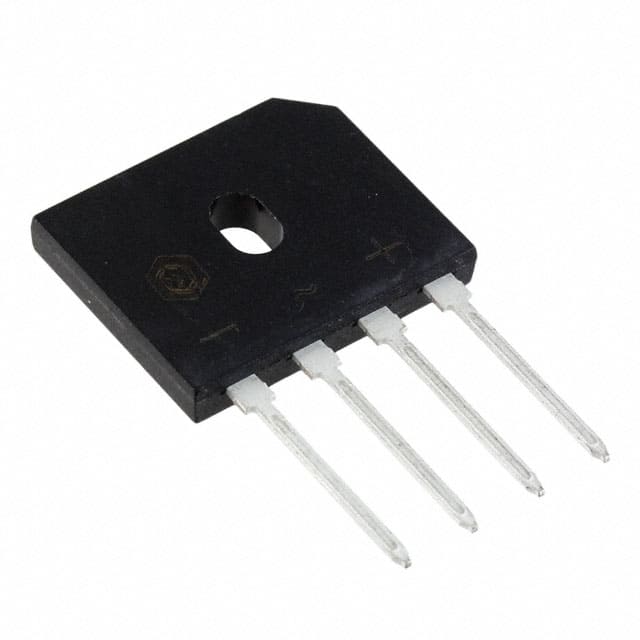Consulte las especificaciones para obtener detalles del producto.

GBU10D Diode Bridge Rectifier
Product Overview
The GBU10D diode bridge rectifier belongs to the category of electronic components and is commonly used in power supply circuits to convert alternating current (AC) to direct current (DC). Its characteristics include high efficiency, compact size, and reliable performance. The package typically consists of a molded plastic body with metal terminals for connection. The essence of the GBU10D lies in its ability to efficiently rectify AC voltage into DC, making it an essential component in various electronic devices. It is commonly available in packages containing multiple units.
Specifications
- Maximum Average Forward Current: 10A
- Peak Repetitive Reverse Voltage: 1000V
- Maximum RMS Voltage: 700V
- Forward Voltage Drop: 1.1V
- Operating Temperature Range: -55°C to 150°C
Detailed Pin Configuration
The GBU10D typically has four pins, with two pins designated for the input AC voltage and the other two for the output DC voltage. The pinout configuration is as follows: - Pin 1: AC Input Terminal 1 - Pin 2: AC Input Terminal 2 - Pin 3: DC Output Terminal 1 - Pin 4: DC Output Terminal 2
Functional Features
- Full-wave Rectification: Converts both halves of the input AC waveform into DC.
- High Efficiency: Minimizes power loss during the rectification process.
- Compact Design: Suitable for space-constrained applications.
- Reliable Performance: Ensures stable DC output under varying load conditions.
Advantages and Disadvantages
Advantages
- Efficient conversion of AC to DC
- Compact size
- Reliable performance
- Wide operating temperature range
Disadvantages
- Higher forward voltage drop compared to some alternative models
- Limited maximum average forward current
Working Principles
The GBU10D operates on the principle of diode bridge rectification, where the arrangement of diodes allows for the conversion of AC voltage into DC. During the positive half-cycle of the input AC waveform, one pair of diodes conducts, allowing current to flow through the load in one direction. During the negative half-cycle, the other pair of diodes conducts, ensuring continuous DC output.
Detailed Application Field Plans
The GBU10D is widely used in various applications, including: - Power supply units for consumer electronics - Industrial control systems - Automotive electronics - LED lighting systems - Renewable energy systems
Detailed and Complete Alternative Models
Some alternative models to the GBU10D diode bridge rectifier include: - GBU6D: Lower maximum average forward current but suitable for lower power applications. - GBU25D: Higher maximum average forward current for more demanding applications. - GBU10M: Similar specifications but with a different package design for specific mounting requirements.
In conclusion, the GBU10D diode bridge rectifier is a crucial component in power supply circuits, offering efficient AC to DC conversion, compact design, and reliable performance. Its wide application field and availability of alternative models make it a versatile choice for various electronic systems.
Word Count: 413
Enumere 10 preguntas y respuestas comunes relacionadas con la aplicación de GBU10D en soluciones técnicas
What is the GBU10D?
- The GBU10D is a bridge rectifier diode module commonly used for converting alternating current (AC) to direct current (DC) in technical solutions.
What is the maximum voltage and current rating of the GBU10D?
- The GBU10D typically has a maximum voltage rating of 1000V and a maximum current rating of 10A.
How is the GBU10D typically mounted in a circuit?
- The GBU10D is usually mounted on a heat sink to dissipate heat and ensure proper operation.
What are the typical applications of the GBU10D?
- The GBU10D is commonly used in power supplies, industrial automation, motor control, and other electronic systems requiring AC to DC conversion.
What are the key features of the GBU10D?
- The GBU10D features high surge current capability, low forward voltage drop, and high isolation voltage.
What are the temperature specifications for the GBU10D?
- The GBU10D typically has an operating temperature range of -40°C to 150°C.
What are the important considerations when designing with the GBU10D?
- Designers should consider thermal management, voltage and current requirements, and proper mounting techniques when using the GBU10D in technical solutions.
Are there any recommended alternative components to the GBU10D?
- Some alternative bridge rectifier diode modules similar to the GBU10D include the GBU6D and GBU8D, which have lower voltage and current ratings, respectively.
What are the common failure modes of the GBU10D?
- Common failure modes include overheating due to inadequate heat dissipation, overvoltage spikes, and excessive current flow.
Where can I find detailed technical specifications and application notes for the GBU10D?
- Detailed technical specifications and application notes for the GBU10D can be found in the manufacturer's datasheet and application guides, as well as through authorized distributors and online resources.

